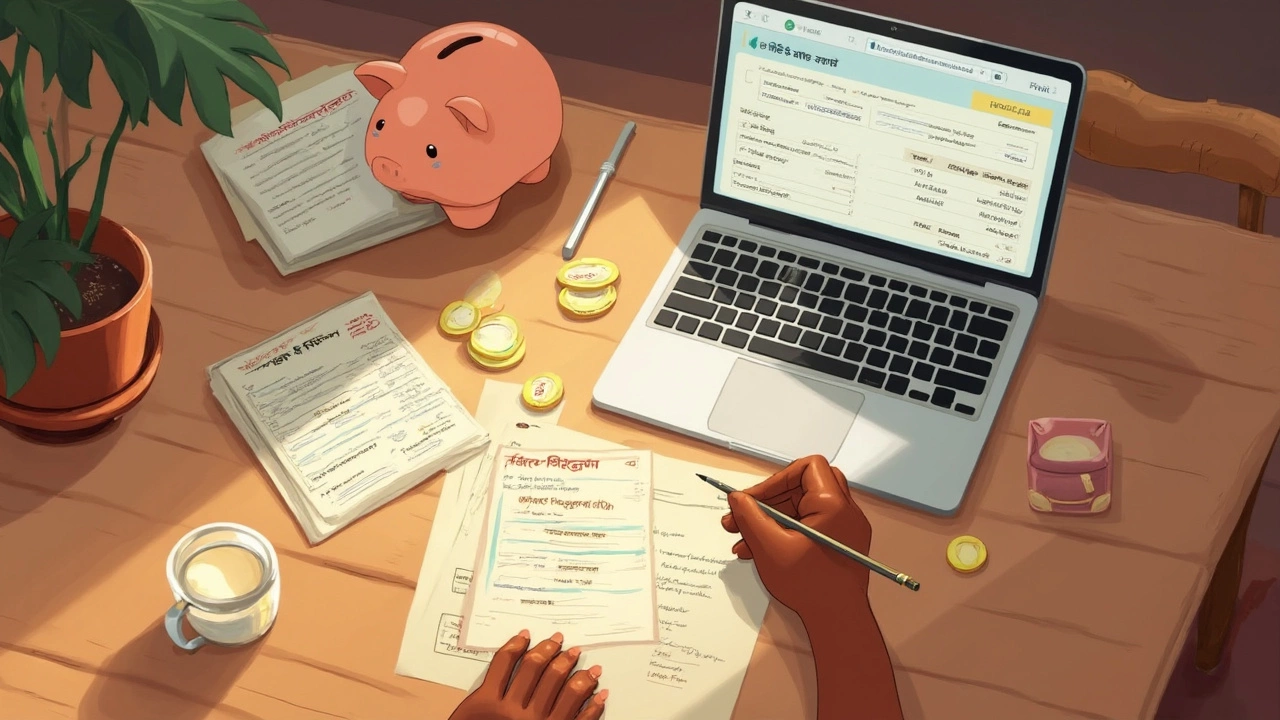The numbers can be jarring. One day, you’re sipping coffee, and then a roofer says your house needs a new roof—yeah, the one that'll set you back more than your last vacation, or even two of them. Before diving in, it pays to know exactly what you’re up against. Roofing companies toss around ballpark figures, but ballparks are huge. The final bill can really catch you off guard if you’re not ready.
If you’re like most folks, you don’t have thousands set aside just waiting for shingles to fail. Here's the deal: budgeting for a roof takes more than a wild guess and a Google search. Materials, labor, and sneaky extras add up fast. The price will depend on your home's size, what kind of shingles you're eyeing, and even the pitch of your roof—steep ones cost more because they’re a pain to work on.
- Figuring Out the Real Roof Cost
- Breaking Down the Big Expenses
- Hidden Costs Nobody Tells You About
- Smart Ways to Save Up for a Roof
- Mistakes People Make with Roof Budgets
Figuring Out the Real Roof Cost
If you’ve never replaced a roof before, the wide range of prices out there can seem nuts. The average American homeowner spends between $8,000 and $15,000 to replace a roof, but in some cases, bigger homes or fancy materials can push that north of $25,000. The real trick? Nailing down what your specific project will cost, not some mystery house on the internet.
Start with square footage. Roofers often charge "per square"—that’s roofer lingo for every 100 square feet. Asphalt shingles, the most common choice, usually run about $4.50 to $7 per square foot (materials plus labor, as of early 2025). Metal roofs or premium shingles? Expect $8 to $15 per square foot or more. It adds up fast, especially if you’ve got a bigger house or want a look that really pops.
Here’s what’s smart: get three actual quotes from licensed, insured contractors. Don’t settle for a phone estimate—insist on an in-person visit. Every house is different, and a real walkthrough lets pros spot possible rotten wood, multiple layers of old shingles, skylights, chimneys, and other things that can shift the bottom line.
- Check which permits your city requires. Permits can tack on $200 to $1,000 depending on your city.
- Factor in disposal fees. Dumping old shingles can run $50 to $100 per ton.
- If your roof has a really steep pitch or tough access, labor rates go up—sometimes by 15% or more.
One more thing: plan for surprises. Water damage or hidden rot usually means extra costs. A rule of thumb is to add a 10-15% buffer to whatever number you settle on, so nothing catches you off guard. That’s the best way to tackle your roof budget and avoid sticker shock later.
Breaking Down the Big Expenses
People always ask, "Where does all the money go when you're paying for a roof?" Honestly, it’s not just about shingles. There's a whole chain of costs, and if you skip understanding them, you'll get a nasty surprise when the invoice lands.
First up, materials. Asphalt shingles are the most common and affordable, running about $100 to $150 per square (that’s roofer talk for 100 square feet). Fancy stuff like metal or tile kicks the price up big time—think $300 to over $1,000 per square, depending on the style and brand. Most homes in the U.S. need between 20 and 30 squares. That math adds up fast. But materials are just the start.
Labor often takes the largest piece of the pie. Roofers don’t just slap on shingles; there’s old stuff to strip, repairs to the underlying wood, and all the flashing, vents, and safety gear. According to the National Association of Home Builders, labor can eat up about 60% of the total roof cost. That means if your project hits $10,000, about $6,000 goes to hands-on work.
"Homeowners are often surprised that installation labor and disposal together can be more than the price of the shingles themselves." — Roofers Guild, 2024 Industry Report
Next, there are tear-off and disposal fees. Old shingles and junk don’t vanish on their own. Removing and hauling can add $1,000 or more, depending on the roof size and how many layers need to go. Plus, landfills charge by the ton. That's money just for getting rid of old material.
Don’t forget permits and inspections. Most towns require a permit before contractors start, and these are never free. Permit prices fall anywhere from $150 to $500, and sometimes a little more in big cities. Skip this and you risk fines or problems if you sell your home.
| Big Expense | Typical Cost Range |
|---|---|
| Shingles & Materials | $2,000–$7,500 |
| Labor (Install & Tear-off) | $5,000–$12,000 |
| Disposal Fees | $1,000–$2,000 |
| Permits & Inspections | $150–$500 |
Here’s a pro tip: Always ask your roofer for a clear breakdown. A quality estimate lists every line item. Miss this step, and your roof budget will probably get wrecked by "extras" you didn’t see coming.

Hidden Costs Nobody Tells You About
The sticker price you get from a roofer rarely tells the full story. Honestly, the little things can snowball and jack up what you thought was a simple job. These hidden costs are what catch most folks off guard.
- Plywood replacement: Your roofer might pull up those old shingles and find moldy, rotten, or broken wood underneath. It’s common. Fixing or replacing sheets of plywood isn’t always included in your quote. Each sheet can run $70 to $100. Some medium-sized houses need 8–10 sheets swapped out.
- Permits and fees: Most towns won’t let you just start hammering away. If you skip getting a permit, you could end up paying fines. Permits can range from $200 all the way to $900 in bigger cities.
- Disposing old roofing: Getting rid of the old shingles isn’t free. Roofers often charge for dumpsters or haul-away. This can add $400–$1,000, especially if your roof has multiple layers.
- Upgrades & code stuff: Sometimes the building code has changed since your last roof job. Suddenly, you’re looking at ridge vents, extra ice barrier layers, or flashing upgrades. Each one adds to the final bill.
- Weather delays: If rain or crazy heat drags your project out, labor costs can creep up. No joke—it’s common for jobs to run over if bad weather hits during your scheduled week.
Here's a quick snapshot of how these add-ons can pile up:
| Hidden Cost | Low End | High End |
|---|---|---|
| Plywood Replacement | $560 (8 sheets) | $1,000 (10 sheets) |
| Permits | $200 | $900 |
| Old Roof Disposal | $400 | $1,000 |
| Code Upgrades | $300 | $1,500+ |
If your roof budget doesn’t leave wiggle room for these kinds of charges, you’ll be reaching into your emergency fund or, worse, your credit card. It pays to ask your roofer, up front, what’s included and what isn’t—and then plan for at least 10–15% extra, just in case.
Smart Ways to Save Up for a Roof
Saving for a roof isn’t something you just wing. A strong plan makes paying those bills a lot less stressful. Roofs aren’t cheap, with the average roof replacement in the U.S. costing between $8,000 and $15,000 in 2024. If you have a complex roof or choose high-end materials, that number climbs fast. But there are ways to soften that hit.
The first step? Set up a separate savings account just for your roof. This stops you from casually dipping into the fund for other stuff, plus, it's easier to track your progress. Break down the total you need and set a monthly goal. Even $100 here and there adds up. Automatic transfers help so you don’t forget.
- Roof budget tip: Ask your roofer for a detailed written estimate. This lets you set a real savings target instead of guessing. Get a few quotes for peace of mind.
- Find out if your roof insurance covers any part of the job—some policies help with weather damage.
- Look into energy efficiency rebates. Cool roofs or certain shingles can qualify for local or federal kickbacks. That’s real money back in your pocket.
- If your credit is good, a zero-interest credit card offer can help if you’re a few grand short and you KNOW you can pay it off in time.
- Don’t forget about local grant programs. Some cities and nonprofits help pay for repairs—especially if you’re in an older home or low-to-moderate income bracket.
Some folks get creative: pool tax refunds, side hustle cash, or even cash-back rewards right into the roofing pot. Monica and I once ran an online garage sale and put $1,700 towards a home repair bill. You’d be shocked how quickly unused stuff adds up.
Here's a breakdown of how you might stash away money:
| Savings Method | Monthly Amount | 1-Year Total |
|---|---|---|
| Direct deposit/auto transfer | $150 | $1,800 |
| Tax refund allocation | $500 (one time) | $500 |
| Side hustle/gig work | $100 | $1,200 |
| Cutting monthly expenses | $75 | $900 |
By combining small changes, the money starts rolling in faster than you’d think. The trick? Stay consistent and treat your roof fund like a must-pay bill. Skip it for a few months, and you’ll be scrambling when your shingles turn into a sieve during the next rainy season.

Mistakes People Make with Roof Budgets
It’s way too easy to mess up when setting aside money for your roof. Lots of folks think grabbing a quick estimate from the first roofer they Google is enough. But roofs are a big deal and one misstep can leave you broke or with water dripping into your home. Let’s break down the classic mistakes people make, so you can steer clear of them.
- Guessing instead of researching: Most homeowners just Google “cost of a new roof” and trust that first number they see. The real cost depends on your material, roof pitch, square footage, and even your zip code. National averages are usually off by thousands.
- Ignoring the "what-ifs": Even on a basic job, there’s a chance workers will find bad decking or hidden leaks. These surprises are super common. A survey from HomeAdvisor found that unexpected repairs boost roof budgets by an average of 20%.
- Forgetting about the extras: Permits, disposal fees, gutters, and cleanup? They don’t always pop up in the first quote from the company, but they show up on your invoice—a rude awakening if you didn’t plan for them.
- Not getting multiple quotes: People tend to settle for the first roofer that calls back. You could end up paying 10-20% more than you need to. Getting three bids almost always results in a lower price and a better understanding of what's out there.
- Skipping the warranty check: A roof's warranty is not just a line on the contract. Replacement and repair warranty terms can save or cost you thousands over time. Some companies offer limited coverage that barely helps if problems pop up later.
- Blowing the whole stash on the roof: It’s a mistake to empty your emergency fund on a new roof and not leave any backup for surprises. Always keep some cash aside.
Here’s a quick look at how costs and mistakes add up, based on real averages:
| Expense/Mistake | Average Extra Cost (USD) | How Often It Happens |
|---|---|---|
| Hidden Structural Damage | 2,000 | 40% of jobs |
| Missing Permits or Fees | 300 | 50% of jobs |
| No Multiple Quotes | 1,500 | 60% pay too much |
| Forgotten Cleanup/Disposal | 250 | Every job |
If you focus your roof budget on just the sticker price, you’re basically asking to spend more later. The smartest move? Factor in extras, get several quotes, and always leave room for the stuff no one tells you about up front. That’s how you get a real handle on your roof budget and avoid those wallet-busting mistakes.


